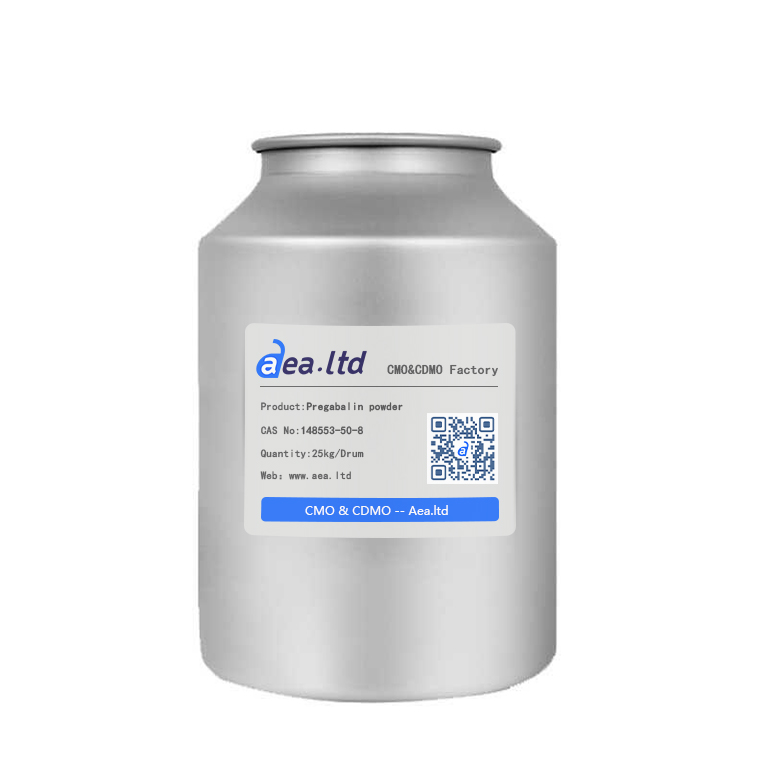Pregabalin powder
Pregabalin powder is white powder whch used as an anti-epileptic drug, also called an anticonvulsant. It works by slowing down impulses in the brain that cause seizures. Pregabalin powder also affects chemicals in the brain that send pain signals across the nervous system. [1] [2]World's Largest Pregabalin Powder Manufacturing Plant - Aea.ltd
Pregabalin powder is used to treat pain caused by fibromyalgia, or nerve pain in people with diabetes (diabetic neuropathy), herpes zoster (post-herpetic neuralgia), or spinal cord injury.[3]
Pregabalin powder is also used with other medications to treat partial onset seizures in adults and children who are at least 1 month old.Pregabalin raw powder may also be used for purposes not listed in this medication guide.
Pregabalin Mechanism of Action Pregabalin is an anticonvulsant drug used to treat neuropathic pain conditions and fibromyalgia, and for the treatment of partial onset seizures in combination with other anticonvulsants.[4]
Although the mechanism of action has not been fully elucidated, studies involving structurally related drugs suggest that presynaptic binding of pregabalin to voltage-gated calcium channels is key to the antiseizure and antinociceptive effects observed in animal models.[5]
By binding presynaptically to the alpha2-delta subunit of voltage-gated calcium channels in the central nervous system, pregabalin modulates the release of several excitatory neurotransmitters including glutamate, substance-P, norepinephrine, and calcitonin gene related peptide.In addition, pregabalin prevents the alpha2-delta subunit from being trafficked from the dorsal root ganglia to the spinal dorsal horn, which may also contribute to the mechanism of action. Although pregabalin is a structural derivative of the inhibitory neurotransmitter gamma-aminobutyric acid (GABA), it does not bind directly to GABA or benzodiazepine receptors.
Uses/Application of Pregabalin
❶ Pharmacological efficacy: Pregabalin is a novelγ-aminobutyric acid (GABA) receptor agonist, can block the voltage-dependent calcium channels to reduce neurotransmitter release.
❷ The main clinical for the treatment of peripheral neuropathic pain as well as part of adjuvant treatment of focal seizures.
❸ Treatment of epilepsy in developing the most promising drug in a drug treatment better and more convenient administration. It can also be used to treat pain and anxiety.
Side Effects of Pregabalin Like most medications, Lyrica can cause mild or serious side effects. This is not a complete list of side effects and others may occur. A healthcare provider can advise you on side effects. If you experience other effects, contact your pharmacist or a healthcare provider.
Common Side Effects
You may experience side effects while taking pregabalin. The common side effects of pregabalin include:
▪ dizziness
▪ drowsiness
▪ confusion
▪ blurred vision
▪ tremor
▪ unsteadiness when walking
▪ weight gain
▪ constipation
▪ dry mouth.
Severe Side Effects
Call your provider right away if you have serious side effects. Call 911 if your symptoms feel life-threatening or if you think you have a medical emergency. Serious side effects and their symptoms can include the following:
▪ Suicidal thoughts or suicide attempts: Symptoms may include suicide attempts, new or worsening anxiety or depression, trouble sleeping, agitation, acting on dangerous impulses, and unusual changes in mood or behavior.
▪ Severe allergic reactions: Symptoms may include trouble breathing, hives, and swelling of the tongue, lips, mouth, or throat.
▪ Heart problems
▪ Serious breathing problems
Some side effects may get better over time, while others such as dizziness and drowsiness may last as long as you take the medicine.
Pregabalin Storage People should store this medication at a controlled room temperature, about 68 degrees to 77 degrees Fahrenheit.
If traveling, always carry your medication with you and keep the original prescription-labeled bottle or box in your carry-on bag. Don’t leave this medication in your car, especially in very cold or hot temperatures.

